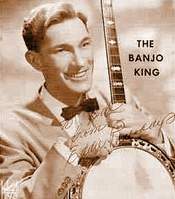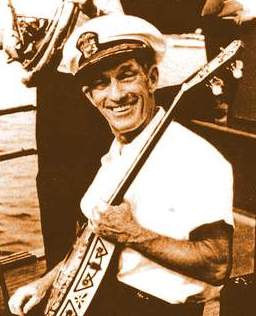Other Banjo Music
Of course banjo music has never been exclusive to bluegrass
and mountain music.
Banjo music also took other directions in addition to bluegrass
in this time period. About 1912, Vega in an effort to promote
a banjo with steel strings for greater volume that could be strummed
with a pick like a mandolin inspired Vega to create the "Tango Banjo" named for the
popular dance of the day, this for dance bands. The tango banjo name soon became slurred
and called a tenor banjo.
At the time of this writing I have yet to find the origin of the Plectrum
4 string banjo, my guess is it was created during the heyday of Banjo Bands
removing the 5th string primarily from the standard 5 string banjo. The tenors
had 17 or 19 frets, the plectrums 22 again essentialy a 5 string short the drone string and tuned
differantly.
The Plectum banjo became very popular and went Ragtime, Dixieland even Big Band as well
all using the plectrum style playing.
One the best known plectrum players was Eddie Peabody.
Credited for popularizing the "Plectrum " style of playing. The plectrum
style was much akin to earlier minstrel players, strumming chords
and mimicking the triplets used in early banjo days often with chords as opposed
to single strings. The main differance being strumming was done with a single flat pick,
as opposed to fingers.Took alot of dexterity and a quick wrist to say the least.
|

Soundclip
Eddie Peabody By The Light Of The SilveryMoon
| Eddie Peabody born in 1901 began his career following his discharge
from the Navy after WW1. In 1925 he wowed the audience at the Granada Theatre
in San Fransisco. The packed crowd had come to see Rudy Valee, but soon
his performance grew to a major production, and he began headlining 52 weeks
a year. Eddie, stood only 5'5" tall but soon became known as the King of the Banjo.
He is credited with popularizing the plectrum style banjo, the use of a flat pick
as opposed to fingers. His music embraced ragtime, dixieland and big band
numbers.
|
He began recording music as early as 1924 under the Dot music
lable. He appeared in Babes On Broadway with Mickey Rooney and Judy Garland
in 1941. He performed in vaudeville, radio , movies and television during
his lifetime.
Eddie was known throughout the world, not just the United States for his
banjo playing. He played command
performances for the Duke of Windsor, King Gustav of Sweden, King George
of England, and Presidents Roosevelt and Harry S Truman.
|
Eddie played on many banjos, most notably Vox by Vega. This banjo was of a
top tension design. Top-tension banjos were first made and patented by George Teed of New
York City in the 1860's. Around 1886, he added a deep-walled resonator
to it. Later, classical player and composer Joseph Cammeyer, of Brooklyn,
modified the design and took it to England, where it became popular as
the English "zither" banjo.
Plectrum artist, Eddie Peabody, is credited with bringing the design back
to America, where it was further refined by the Vega Company of Boston, and
became one of the most unique Jazz banjos of the late 1920's and early
'30's.
|

Eddie Peabdoy and his
Vox by Vega Banjo
|
Folklore is in later
years, he
often supplemented his earnings, by scouting out old Tenor banjos in pawn shops
during touring. He would use the banjo for a song or two onstage, then
sell it backstage after the performance, along with a good mark up for
the ability to say " this was Eddies banjo". Banjo dealers are regailed
with this information often, how much truth there is to it cannot be verified.
He's also credited with inventing an instrument called a 'Banjoline'
Six strings tuned like a plectrum banjo.
 Eddie Peabodies Banjoline
Eddie Peabodies Banjoline
Although Eddie recorded at least one album with all Banjoline
tunes, the instrument never caught on.
Sort of a hybrid electric 6-string banjo-guitar that sounded somewhat
like a Hawaiian guitar, but was tuned just like a plectrum banjo.
The 1st and 2nd strings were not doubled.
The third string was doubled, and the two strings were tuned
in unison (like the doubled strings of a mandolin).
The fourth string was also doubled, but the two strings were tuned
an octave apart. Banjolines were sold for a short time by
the Rickenbacker and Fender Guitar Companies.
Its clear though that Eddie Peabody was the top in his field for more than
four decades. He helped bring back the banjo to the entertainment industry
again. Eddie passed away at the age of 69 following a performance in Kentucky
in 1970. His style of banjo is still being played today, and there are many
audiences still enjoying the sound of plectrum banjo playing.
|
MORE ABOUT
|

